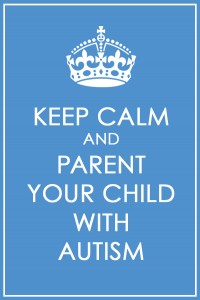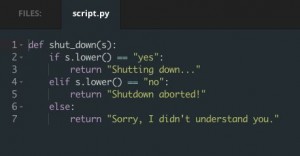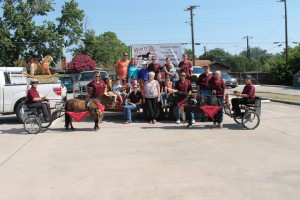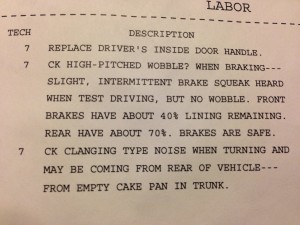problem-solving
To work
When Sam graduated high school and got his first job sacking groceries for customers at Albertsons, a dear friend and knowledgeable researcher told me that he would grow up a lot from the experience. He was right. The things you need to grow and be successful on the job, even just organizing your life in a reliable way, are quite demanding.
Sam grew up a lot that first year, thanks to the world of work.
He’s on the cusp of another job search, one that we hope will stick a little better than we’ve been able to do on our own since he graduated from North Central Texas College in December 2012 with his associate’s degree. He’s qualified for the same kind of help that helped him land that first job.
I cannot underscore how important these programs are. Researchers at Vanderbilt and the University of Wisconsin-Madison agree that underemployment is a common among adults with autism like Sam and programs are needed to address the problem. How big? About half of adults with autism — a growing population — spend their days in segregated settings of work, or other activities, with contact with the rest of the community.
Which isn’t good for the community, either, by the way.
What else did those researchers find? Here you go:
More independent work environments may lead to reductions in autism symptoms and improve daily living in adults with the disorder, according to a new study released in the Journal of Autism and Developmental Disorders.
Researchers at Vanderbilt University and the University of Wisconsin-Madison examined 153 adults with autism and found that greater vocational independence and engagement led to improvements in core features of autism, other problem behaviors and ability to take care of oneself.
“We found that if you put the person with autism in a more independent vocational placement, this led to measurable improvements in their behaviors and daily living skills overall,” said lead author Julie Lounds Taylor, Ph.D., assistant professor of Pediatrics and Special Education and Vanderbilt Kennedy Center investigator. “One core value in the disability community and at the Vanderbilt Kennedy Center is placing people with disabilities in the most inclusive environments possible. In addition, this study gives us evidence that increasing the level of independence in an employment or vocational setting can lead to improvements in autism symptoms and other associated behaviors.”
Participants averaged 30 years of age and were part of a larger longitudinal study on adolescents and adults with autism. Data were collected at two time points separated by 5.5 years.
Taylor, in collaboration with colleagues at the University of Wisconsin-Madison, looked at such autism symptoms as restricted interests, repetitive behaviors, communication impairments and difficulties with social interactions and found the degree of independence in vocational activities was uniquely related to subsequent changes in autism symptoms, other problem behaviors and activities of daily living.
The results provide preliminary evidence that employment may be therapeutic in the development of adults with autism. Similar to typically developing adults, vocational activities may serve as a mechanism for providing cognitive and social stimulations and enhance well-being and quality of life.
One book every ten years
I’ve been told more than once that the purpose of your first book is to help get your contract for the second one. (Also, I’m told to not quit your day job until after the third book is published, but I keep doing the math and I think that advice is for fiction writers.)
I’ve noticed that some writers are better than I am about coming up with topics for books. A children’s writer down the road from me, Lynn Sheffield Simmons, gets her inspiration from animals and her little books are now in accelerated reader programs in elementary schools. My good friend, Donna Fielder, follows the headlines with her terrific true crime books. She also works with really funny material from her column writing — it seems like she always has a project in some stage of development.
It has been almost a decade since I developed my last manuscript and managed to have “See Sam Run” published. The next one is coming along, thanks to an extraordinary collaborator, Shahla Ala’i-Rosales.
Shahla has worked with parents and children with autism for years, has helped educate a generation of certified behavior analysts, and produces informed research on the topic. It has taken us several years to put together what we hope will be a timeless guide for parents, young and old, who love and care for a child (or adult) with autism.
It’s basically this idea:
This is no easy task, y’all.
But Shahla and I have come to recognize that behavior analysis and mindfulness intersect in a way that can be powerful and life-altering for parents, their personal and professional allies, and the children in their care.
Here’s a sneak peek from our proposal:
Our book starts in territory that others have explored – the emotional landscape above which all the hard work of raising a child takes place – and moves into the extraordinary territory parents of children with disabilities must work in. As no one has written about mindful parenting and parenting children with disabilities for general audience, our book will break new ground.
Parents make decisions for their children every day. Parents of children with disabilities often make more decisions, and sometimes continue to do so for the duration of their child’s entire life. Many of those parents also recognize that their children may lack the resilience to bounce back as quickly, if at all, if a decision turns out to be a mistake. Those decisions can often feel high-stakes to parents.
Through its conversational tone, accessible to busy and overwhelmed parents, this book will both offer parents stories that are insightful and steer them towards tenets unified by time-tested, wisdom-based principles. The work is also grounded in the ethical guidelines used by professionals. In this way, the book echoes not only emerging market in mindfulness and parenting but also emerging research on mindfulness …
And the trail ride
Sam loaded this video to his own YouTube channel. Michael shot it, and you can hear him at one point chiding the horse, Trevor, who didn’t appear to cooperate at the gate.
Tonight Sam talked about this ride in a way that he hadn’t shared before. I had walked by him sitting in the recliner on my way to my own chair in the living room and gave his knee a pat.
This is something that typically makes him recoil from my touch, so I rarely do it, but I try from time to time. He recoiled, of course.
But after doing so, he told me that he had strong reflexes and that it can be a problem when riding horse. He said that he has to try to control them, otherwise his body sends the horse the wrong signal of what he wants to do.
“Like when we were at the gate,” he said.
Adaptation
A friend warned us after Dixie was diagnosed with diabetes one month ago that she would go blind. I wish I’d known how fast that would come. She already had cataracts going into this (an early sign, perhaps) and last week, before the ice storm, she got an infection in one eye.
By the weekend, her vision was completely gone.
I saw my home in a new way. It is not, by any stretch, an age-in-place kind of abode. But I downloaded a primer with 65 tips on how to help a dog that has gone blind. We’re doing what we can.
What’s been tough for Dixie is the speed of the loss. She hasn’t had a lot of time to adapt, the way you might if your vision slowly fades from aging. The ice storm didn’t help either. She has the most confidence when we get the leash and go for a walk outside, but the ice is cruel. It hides important clues under the feet and yields unexpectedly.
The storm allowed me time to observe her closely and make changes we needed to make quickly and speed her adaptation. But, for a few days, I also watched her wake up each morning, and from naps, having forgotten for a brief moment that she was blind.
Just like other December mornings some years ago, when I woke up each morning not remembering, for one or two glorious seconds, that Mark was gone.
Overheard in the Wolfe House #250
Sam (seeing an email address found via gmail search): Do you know how to export that contact?
Peggy: Can’t I just write it down for you on a piece of paper?
Overheard in the Wolfe House #248
Fifty shades of attention
Sometimes the best conversations you have with your kids are in the car on the way somewhere, or while you’re working on something together. I don’t understand why it worked, but we’d get revelations from Michael as we did fence repairs for the goats, for example, or from Paige after we’d get going on sewing project together.
Only in the past few weeks did I come to realize that wasn’t really the case for Sam.
Of course, when he was little, and we discovered that giving him our full attention managed to coax more language and social development out of him, we gave it our all. Mark even took a square tabletop off its pedestal leg and put foot-high 2x2s under all four corners for a play table. We spent hours sitting at that play table with him. Sometimes, it became just like a family dinner table in Japan. We cleared off the toys and sandpaper letter cards and other learning materials and ate our meal there (usually in front of a baseball game, we weren’t saints.)
As Sam grew and his language and schooling caught up, there was much less direct time like that together. We chatted at the dinner table, in the car, just like we did with his brother and sister.
In recent years, though, we noticed that Sam often had false starts to his sentences. Paige mentioned her concerns that she might have to wait for him to start and re-start a sentence as much as four or five times until he could finish it.
I wondered if I needed to find a speech therapist to help him. Sam and I talked about it briefly, and he was amenable. He had speech therapy throughout elementary, middle and high school. We didn’t seek it after that. But I told myself, add it to the list, but not at the top. We’ve got bigger fish to fry (and that’s not a metaphor: we’ve been working on cooking and kitchen management this year.)
While reading a new book on mindfulness, Thich Nhat Hanh’s Peace is Every Step, I had a quiet revelation. (Reading it as part of my work with Shahla Ala’i-Rosales and our new book on mindful parenting for those who have children with autism) What if I gave Sam my full attention when he started a sentence with me? Would that diminish the false starts?
That meant if he started talking to me while I was filling the dishwasher, for example, I was going to have to stop in the middle of my work, not just keep talking and working at the same time. I’ve been in single mom mode for nearly six years now. I recognized this would be training for me, not for him.
I got plenty of reinforcement for the change right away. The false starts diminished almost immediately. I told Michael about it and he was excited for us. He may even take data on my attention and Sam’s sentence starts next time he’s home, if it isn’t completely gone by then.
Shahla told me it makes sense. Many of us have learned that we can carry on a conversation with another person while they are doing something else. But Sam and others with autism may be less sure of the social cues. They may question whether they are communicating. They may think they are making a mistake, Shahla says.
Oh, no. That mistake was mine.
How to be spontaneous
Sam got an email Friday giving him a day’s notice for a chance to ride on a float Born2Be would have in the North Texas Fair and Rodeo parade Saturday morning. He forwarded the email to me. I replied that I already had promised to run trail with Susan Saturday morning, but this looked like something fun he could do on his own.
When I got home from work that evening, he said he just didn’t think that a day’s notice was enough notice for him. Did he have to go to work Saturday? Did he have other plans? He said no. But, from time to time, through the evening, he would talk about the parade. I knew he was thinking about it.
Finally, I reminded him that in the movie, Mama Mia, the character, Harry, had a hard time being spontaneous, but he saw everyone else being spontaneous, so he wanted to try. Maybe you can try to be spontaneous like Harry, I told him.
Sam decided to call someone at B2B for more information, and went to bed early with a tentative plan of how he would fit the parade into his day. Sam’s right, a person does have to lay some groundwork to be spontaneous.
Saturday morning we all were up early, and he was ready to head out the door to get there in time to meet everyone else. He was home by lunch and said he had a great time.
“I’m spontaneous,” he said.
Overheard in the Wolfe House #241
Peggy (passing the dishcloth): Would you wipe that tomato splatter off the pantry door please?
Sam: Yes. I’ve been doing a lot of that today.
Peggy: What do you mean?
Sam: Upstairs, I had to wipe all the dead mosquitos off the ceiling.






